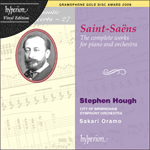
Welcome to Hyperion Records, an independent British classical label devoted to presenting high-quality recordings of music of all styles and from all periods from the twelfth century to the twenty-first.
Hyperion offers both CDs, and downloads in a number of formats. The site is also available in several languages.
Please use the dropdown buttons to set your preferred options, or use the checkbox to accept the defaults.

| Alfred Cortot (piano), Unnamed orchestra, Charles Münch (conductor)» More |
In the ‘Andante’ section a serene chorale melody, quietly introduced by the woodwind, is subsequently treated in the grandest manner. The reflective conclusion of the first part is preceded by a remarkable passage which is effectively an accompanied cadenza. The second part begins with a scherzo section based on a lively chromatic theme from the first part, and soon the very opening theme of the concerto is playfully recalled as a counter-melody. A new 6/8 theme, splendidly uninhibited in its bounding rhythm, is introduced by the piano, and the triumphant concluding section of the work, following a fugal passage, is dominated by an affirmative triple-time version of the original chorale melody.
from notes by Phillip Borg-Wheeler © 2001
Dans l’Andante, un thème de choral serein, discrètement introduit par les bois, est ensuite traité de la manière la plus imposante. La conclusion méditative de la première partie est précédée d’un passage remarquable qui n’est rien d’autre qu’une cadence accompagnée. La seconde partie débute par un scherzo basé sur un thème chromatique plein d’entrain issu de la première partie, et le tout premier thème du concerto est bientôt gaiement repris en contre-chant. Le piano introduit un nouveau thème à 6/8 d’une merveilleuse absence de retenue avec son rythme bondissant, et la conclusion triomphale de l’œuvre, précédée d’un passage fugué, est dominée par une réitération à trois temps du thème de choral initial.
extrait des notes rédigées par Phillip Borg-Wheeler © 2001
Français: Josée Bégaud
Im „Andante“ überschriebenen Abschnitt wird eine heitere Choralmelodie, die ruhig von den Holzbläsern eingeführt wird, anschließend im prunkvollsten Stil verarbeitet. Dem besinnlichen Schluß des ersten Abschnitts geht eine bemerkenswerte Passage voraus, die effektiv eine begleitete Kadenz ist. Der zweite Abschnitt beginnt mit einem Scherzo, das auf einem lebhaften chromatischen Thema aus dem ersten Abschnitt beruht, und bald darauf wird spielerisch in Form einer Gegenmelodie an das eigentliche Eröffnungsthema des Konzerts erinnert. Ein neues Thema im 6/8-Takt, das durch seinen hüpfenden Rhythmus herrlich hemmungslos wirkt, wird vom Klavier vorgetragen, und der triumphale Schlußteil des Werks im Anschluß an eine fugale Passage wird von einer Variante der ursprünglichen Choralmelodie im bekräftigenden Dreiertakt beherrscht.
aus dem Begleittext von Phillip Borg-Wheeler © 2001
Deutsch: Anne Steeb/Bernd Müller
 French School pianists play French Concertos French School pianists play French ConcertosThis set brings together twelve French-trained pianists performing thirteen French works for piano and orchestra of which ten are premiere recordings. Most of the performers knew the composers and worked with them and four works are performed by t ...» More |
 Saint-Saëns: The complete works for piano and orchestra - Vinyl Edition Saint-Saëns: The complete works for piano and orchestra - Vinyl EditionWhen first issued in 2001, this set from Stephen Hough and the CBSO promptly garnered for these artists a second Gramophone Recording of the Year Award, for these are performances which combine all the elegance required for the Frenchman’s music w ...» More |

